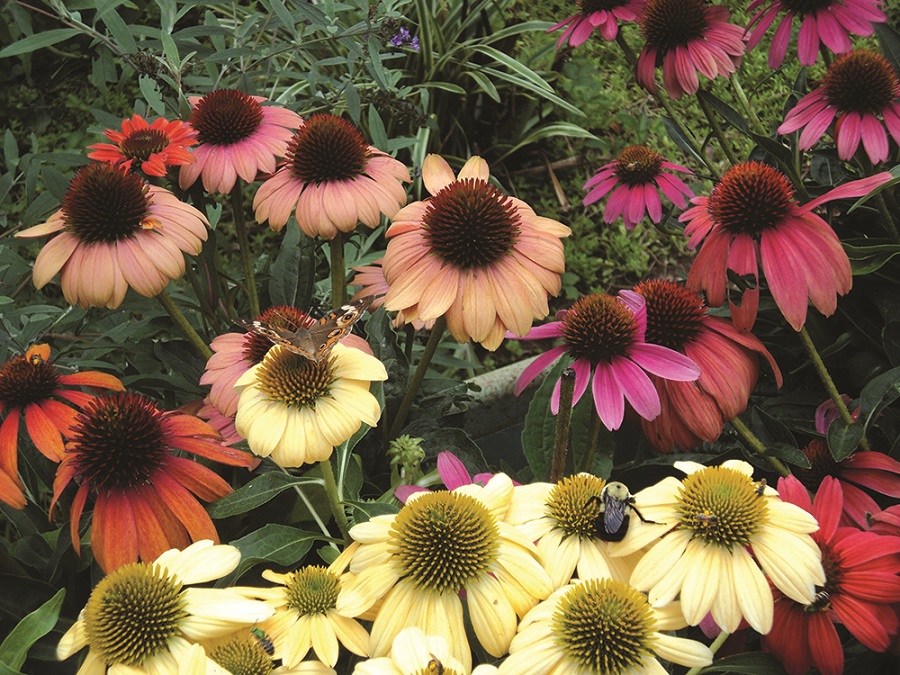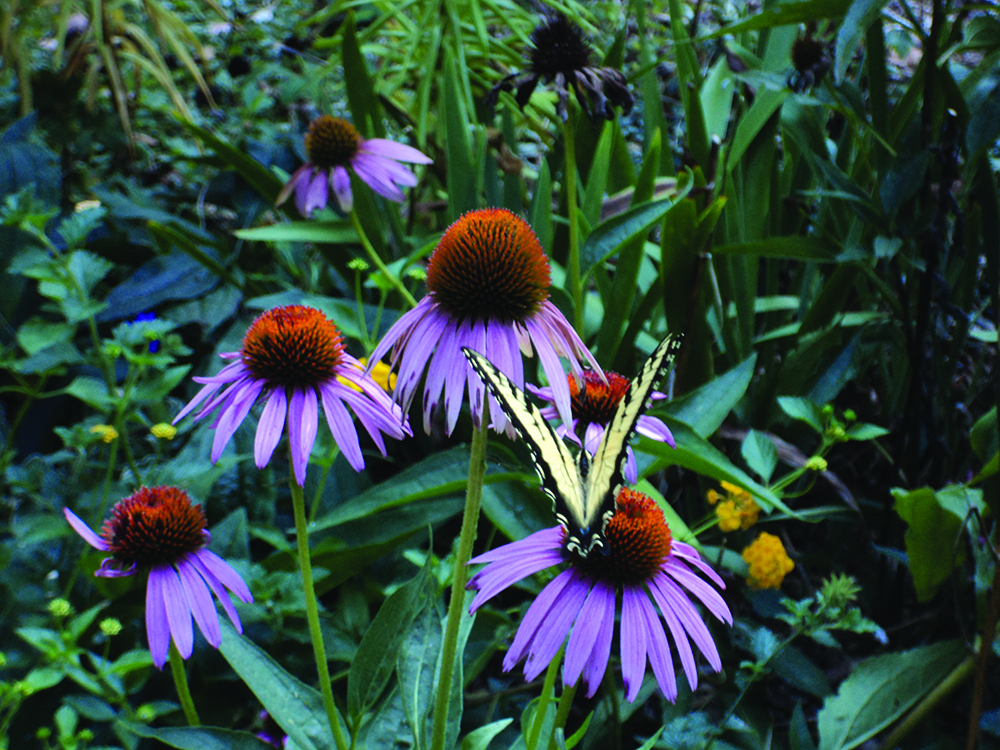Coneflowers seem to cast a spell upon my gardening soul! Their daisy-like flowers, bright colors, long blooming time, and ease of care make them the workhorse of my summer and fall wildlife garden. They are beautiful and dependable, thrive in full sun and heat, have virtually no pest problems and can take less water than most other perennials. They are a reasonably priced plant or I can grow them from seeds; and their nectar-rich centers entice butterflies and honeybees to flock to my garden. Yes, why wouldn’t I be crazy in love with coneflowers!
Here at WillowDale, they are everywhere! Not only do I grow the common purple coneflower ´Echinacea purpurea´ with their huge pinkish flowers, but newer generations with flowers of yellow, orange, white, and reddish purple as seen from last season´s photos. They are a wonderful companion plant with many perennials like lantana, stick verbena, black-eyed Susan, bee balm to name a few. Now, a lot of people think coneflowers are boring…to each their own. But I say that if all gardeners like the same thing, then perhaps our gardens would be boring! Though, adding 2 or 3 coneflowers to a sunny, dry location, just might add a little charm, too.
The purple coneflower is a North American native discovered in Virginia during the 17th century. European explorer John Banister was studying the native flora and happened across the blooms. He harvested the seeds and sent them to England in 1699, where the plant became popular in European gardens by the late 1800´s. In the 1960´s German botanists began to improve upon the species and expanded the available cultivars (selections). They didn’t really take off in popularity in the United States until the 1980´s and in 1998, it won the Perennial Plant of the Year. They are now a common garden staple thanks to intense breeding programs crossing ´Echinacea purpurea´ purple coneflower with other plants in the genus. This has led to various colors as well as double flowering varieties. It is interesting to note that the double-flowered was actually discovered by mistake by Jan van Wisen of The Netherlands. These flowers were in his cut flower fields and were the first of their kind in the world. He passed it off to his friend, Marco van Noort, who successfully marketed it as ´Razzmatazz´ in 2003. It was an immediate hit and led to the breeding and release of many other double coneflowers.
The history of purple coneflower indicates that for over 400 years our Native populations chewed on their pepper-flavored roots or applied it topically as a general cure-all for snake bites, wounds, burns, and pain. They exposed the European colonists to this plant where it was used widely during the 18th and 19th century to treat scarlet fever, malaria, blood poisoning, diphtheria, and more. And Echinacea continues to be used as one of the more popular herbs for its medicinal properties to help the immune system fight off common colds, sore throats, flu and other infections. However, clinical trials have been mixed; many have shown that it is effective, and some have shown that it is not.

The genus name Echinacea comes from the Latin name for hedgehog, echinus, referring to the prickly lower stems and raised cone-like center, hence the name. They are easy to grow…just plant in well-drained soil in a sunny location. No need to fertilize just add organic matter and a little mulch. The nectar-rich flowers draw bees and butterflies and the cone-like center containing seeds bring goldfinches in fall. Deadheading is a must for long blooming time…a plus for butterflies and a minus for birds. So, I cut tomato cages down to 2 rings and place it in the garden near blooming coneflowers. All you have to do is let the spent flowers dry, cut at the base of the stem, place in the cages, and watch the birds feed. Coneflowers grow well in pots but do like a little 10-10-10 during planting. The purple coneflower will reseed and come back for many years, but the newer hybrids usually only last a season or two; and, if they reseed may revert to the purple coneflower. I have planted many hybrids and have been disappointed to say the least. ´Cheyenne Spirit´ is one of the newer hybrids that I have successfully grown year after year in the ground and in pots.
Coneflowers are carefree plants that grow happily in almost any kind of soil. They withstand our cold winters and hot, humid summers and reward us with many colorful blooms. Their sturdy stems make for nice cut flowers; butterflies and bees flock to them; and the seed heads bring goldfinches to your garden. So many reasons to be ´crazy in love with coneflowers´!■



